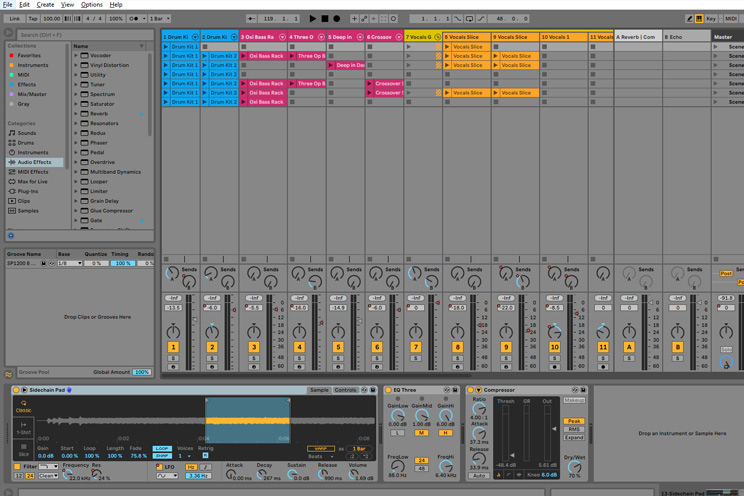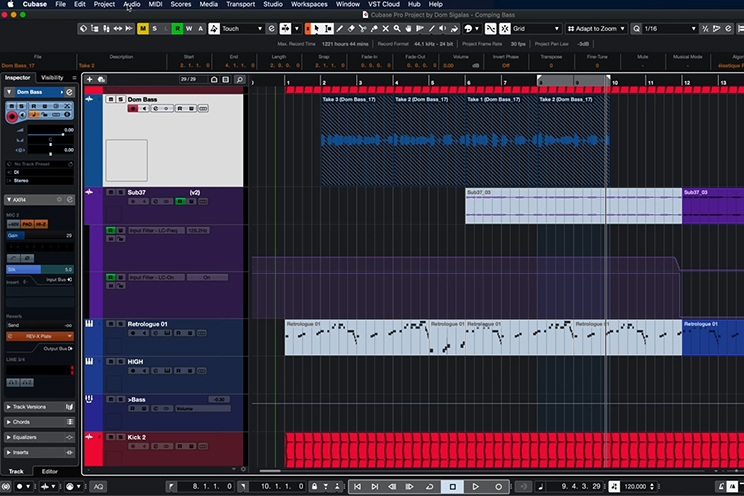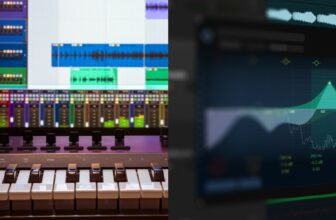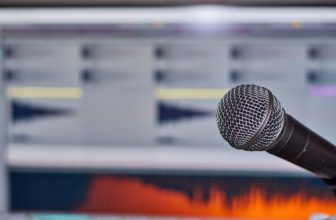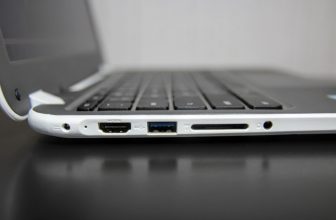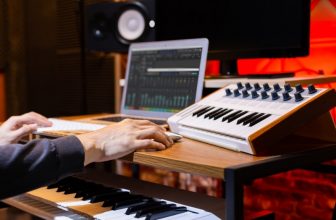Ableton Live vs Cubase – Which is Better?
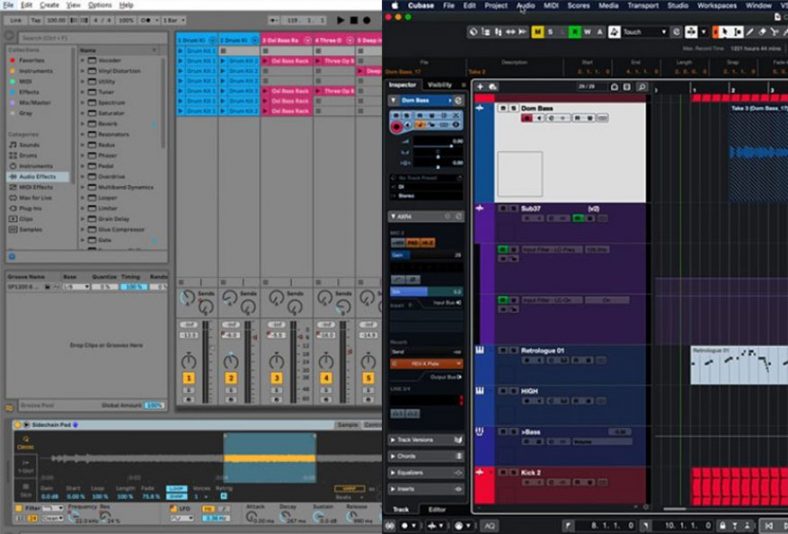
Ableton Live and Cubase are two of the most popular digital audio workstations on the market right now. Musicians from around the world prefer to work with both because they both offer world-class features.
Deadmau5 and Skrillex are among the most well-known users of Ableton Live, whereas Hans Zimmer and Tiesto are among the most ardent supporters of Cubase. This demonstrates that both pieces of software are industry standard and more than capable of delivering the finest possible results in the right hands.
That said, if you are new to the industry and are seeking a good DAW for yourself or are looking to switch software for some reason, let me assist you in learning more about these programs so you can make an informed decision.
Let’s get right into it.
Key Differences
- Cubase is slightly better for arranging large amounts of tracks. Cubase is recognized to be used by several well-known composers and film studios due to its superb and practical capabilities. That said, Ableton Live is also great software to do all these things including mixing and mastering film scores and composition.
- When it comes to Live music, Ableton Live is far more renowned among Live performers, particularly electronic musicians, due to its strong grid-based Live performance view, also known as session view. Cubase doesn’t have any capabilities like this, and as a result, it’s not a popular choice among Live performers.
- The stock plugins and instruments in both Ableton Live and Cubase are fantastic. Both DAWs have excellent sound creation features and samples. The stock plugins in Cubase are generally focused on engineer and studio-friendly mixing and organic sound design, whereas the Ableton Live plugins are usually more focused on Live music performance and electronic sound design.
- The Link tool in Ableton Live enables remote collaborations and allows you to share information and be linked across a local network in a studio or in general. VST transit and VST connect 5 (not included in Cubase Element) are entirely dedicated plugins in Cubase that can be used to collaborate with other musicians in real-time from anywhere in the world as long as they have an internet connection.
- Hardware support is excellent for both Cubase and Ableton Live. Ableton Live’s hardware support, which includes controllers like Ableton push, which covers a range of controllers, is more geared toward Live musicians. Electronic musicians typically prefer it. Cubase’s dedicated CC121 controller is great but more suited to a studio setting.
- Both Cubase and Ableton Live have three different versions to choose from: intro, standard, and suite for Ableton Live, and element, artist, and pro for Cubase. The pricing, on the other hand, is considerably different, apart from the basic versions of both DAWs. Cubase turns out to be more economical than Ableton Live when we progress to the professional editions.
- Although Ableton Live can be used for film scoring and composition, pros such as Hans Zimmer prefer Cubase because of its superior scoring and notation capabilities. The score maker feature is quite useful for creating a score for all of the instrumentalists to use. Ableton, on the other hand, is preferred by Live performers such as Deadmau5, who use it because of its great lopping skills and session view.
Also, be sure to check out our list of the best DAWs for some other great alternatives.
Interface
The arrangement view for both Cubase and Ableton Live are similar. Both DAWs offer a large horizontal timeline in the middle that can be used to rearrange tracks and make modifications. This window acts as the main timeline for your projects, displaying all of the tracks and audio data.
Cubase’s track information is located on the timeline’s left side, where you can find basic track controls as well as the ability to change or rearrange the track sequence. This track information panel is located on the far right of the timeline in Ableton Live. Basic track controls are also available, as well as the ability to rearrange them.
The bottom panel of Ableton Live includes a dedicated master track for all of your tracks, which can be used to drag and drop effects, which I consider to be a very useful feature. The same may be done in Cubase using the tracks panel on the far left of the screen, but the user experience and convenience do not compare to Ableton Live.
The bottom panel in Cubase is dedicated to the mixer/editor area. This creates a separate mixer panel with all of your faders and tracks at your fingertips for rapid mixing. To pull out a mixer in Ableton Live, you would need to go to the session view and select the mixer section instead of the timeline.
In Ableton Live, the far left of the screen is dedicated to a panel that holds all of the loops, effects, and instruments for easy access. Because you can easily and quickly swap between samples while producing, this is a highly useful tool for a quicker workflow. This section is located on the far right of the screen in Cubase.
Of course, all of these sections and the interface are modifiable for usage with multiple monitors, allowing you to extend and arrange them as needed.
Session and loop-based view
Because this functionality isn’t available in Cubase, we’ll focus on Ableton Live and highlight a few important features that I believe make it the ideal program for Live performance and loop-based production.
The session view is considered Ableton Live’s strongest feature, and the majority of professionals use it for Live performances. Because of its amazing Live capabilities and ease of use, Ableton Live is used by most electronic musicians.
The session view is grid-based, allowing the producer to simply insert samples and loops in these grids, allowing them to be exactly timed and called upon whenever needed.
The session view also includes a fully functional mixer that allows you to quickly rebalance or add effects to your sample while on the road, making it one of the software’s most popular features.
When paired with external controllers and hardware equipment, these potentially become even more intriguing. Although you may use hardware controllers and execute Live performances using Cubase, the ease and experience are nowhere near as good as with Ableton Live.
Working with audio
Both DAWs are drastically different when it comes to dealing with audio. The learning curve for Cubase is steep, making it more difficult for novice users to become adjusted to the workflow. From a songwriter’s perspective, it becomes much more difficult to get the creative process started.
Ableton Live has a pretty steep learning curve too. However, if you come from an engineering background or are switching from another DAW like Pro Tools or older versions of Logic Pro, you may find it difficult to adjust to this program as the session view will be new to you.
In comparison, Ableton Live is a great choice for a songwriter, and it only becomes better for electronic artists.
However, if you look at it from the standpoint of an engineer or a studio, Cubase is considerably superior in terms of a studio environment, with good channel strip features, a control room, and other extremely important tools.
Working with MIDI
This is a challenging comparison because Cubase began its life as a MIDI sequencer, making it one of the first midi software programs. As a result, Cubase’s MIDI capabilities are excellent.
Ableton Live, on the other hand, has outstanding MIDI capabilities, which are only enhanced when combined with the session view and Live performance.
As a result, both software packages are quite capable when it comes to working with MIDI. It all boils down to personal preference and what kind of musician you are.
In terms of differences, the only thing I can think of is that if you’re a Live musician, you can use Ableton’s superb MIDI capabilities in Live performances, which makes it even more valuable.
Stock Instruments
Both Cubase and Ableton Live have a wide variety of high-quality stock instruments and plugins. They both have fantastic sound design features as well as superb presets.
Halion Sonic, Groove Agent, Padshop 2, Flux, Trip, Prologue, and other Cubase instruments are well-known. All of these instruments have superb preset sounds as well as sound composition and manipulation features. The synths can perform any type of synthesis.
Cubase also has more realistic acoustic samples and synthesis. The Halion synthesizer comes with a large number of presets that are all organized logically, making it quite efficient in my opinion. On the other hand, Ableton comes with a plethora of stock instruments. Instruments like Impulse, Operator, Simpler, Sampler, Tension, and Wavetable fall under this category.
All of these instruments are excellent for electronic music production, and they are unquestionably among the best stock instruments on the market. However, when it comes to more organic tones, these instruments fall short. If you want more organic sounds like acoustic instruments, you won’t have many possibilities.
When compared to Cubase, the supplied presets with Ableton Live aren’t as nice. You’ll find yourself fiddling with the sounds more frequently, and you’ll almost certainly end up using third-party instruments. For these reasons, I believe Cubase is a superior overall choice if you’re seeking a solid investment.
MIDI Controllers
Both Ableton Live and Cubase come with their own dedicated hardware controllers. These controllers are powerful, and users have enjoyed them immensely.
Ableton Live comes with a dedicated controller for midi sequencing and Live electronic performances. The Ableton Push is an extremely adaptable device that a wide range of musicians use and enjoy. It’s particularly popular and useful in electronic and looping music.
Cubase’s dedicated hardware is more suited to studio use (The CC121 studio controller, which has fantastic integration with Cubase).
Both Cubase and Ableton Live also support a massive amount of 3rd party MIDI controllers if you want to use your own or another controller.
Key Features
Ableton Live
- The session view
The session view, as previously said, is possibly one of Ableton Live’s most compelling selling points. Its Live capabilities are unrivaled and superior to those of any other Digital Audio Workstation currently available.
- Racks
Racks allow you to group MIDI effects, sounds, and instruments into a single memory or device, which can then be recalled and utilized as needed by just clicking a button. Because you never know what sound effect might fit well with a song, this is a really strong sound design tool.
If you already have racks saved, you can try all of them and find the one that is perfect for your compositions. This speeds up the workflow and makes this a highly useful tool.
Max for Live is another new sound design technique from the designers of Ableton Live. It essentially allows you to map your parameters to everything from the song’s tempo to the envelope of a specific instrument and beyond.
This enables incredibly creative and intriguing sound creation concepts to emerge, for example, by manipulating the LFO or filter cutoff using any of the other parameters within the software.
What’s even better, and takes it a step further, is that these gadgets may also be saved for later use. You may also find hundreds of presets created by other musicians online to perform and utilize in your compositions, expanding the possibilities.
Cubase
- Control room
The control room is an essential feature for all studios. This allows you to control everything in your Digital Audio Workstation from a single window. To discover the optimal arrangement, you may effortlessly swap between monitors, recording devices, and other equipment.
The Control room also allows you to create up to four unique mixes for various musicians based on their demands and preferences. The workflow becomes faster and more efficient as a result of this.
By creating unique mixes for each musician, you can make things stand out in a mix that may not be a must for another.
- VST connect
If you work from home or collaborate with someone across great distances, this is another useful tool. This plug-in simply allows you to connect your DAW to the internet, giving you simple access and a smooth workflow even while you are not in the studio.
The use of this is even more valuable during pandemic times when everything is closed and working from home is becoming the norm. This function will allow musicians and songwriters to cooperate over great distances, even if they are on different sides of the world.
- Channel strip
This function may not be beneficial to everyone, but it is tremendously powerful for mixing and mastering professionals. Having a basic default channel strip on each track to make rapid modifications to your songs might be a lifesaver at times.
The channel strip essentially allows you to alter your audio without the use of additional plugins by compressing, limiting, EQ, etc. The channel strip is built-in and pre-installed on all tracks by default, which not only speeds up the workflow but also reduces CPU usage, improving overall performance.
Verdict
In conclusion, both DAWs are great for any musician or producer to work on. Both are industry standards and employed by renowned musicians. Both of these Digital Audio Workstations are capable of producing high-quality music.
At the end of the day, it comes down to the type of workflow you want and the applications you require. As previously said, Ableton Live is the best software for electronic artists and live performances. The Digital Audio Workstation was created with that approach in mind.
On the other hand, with its significantly higher functionality and hardware support, Cubase would be a better alternative for you if you are seeking more studio applications, film scores, or just engineer work.

